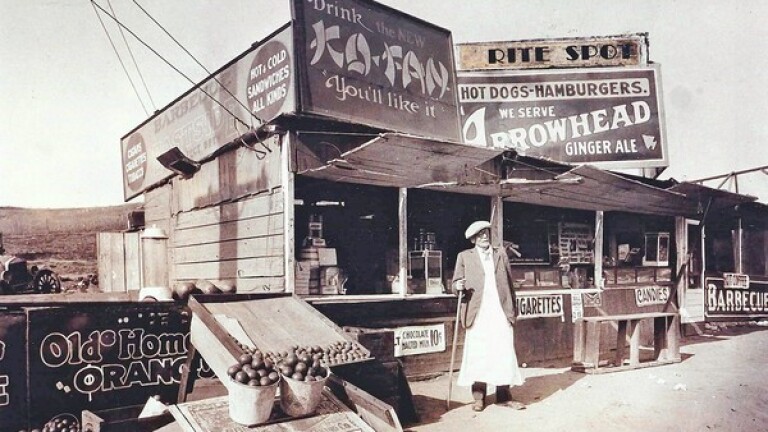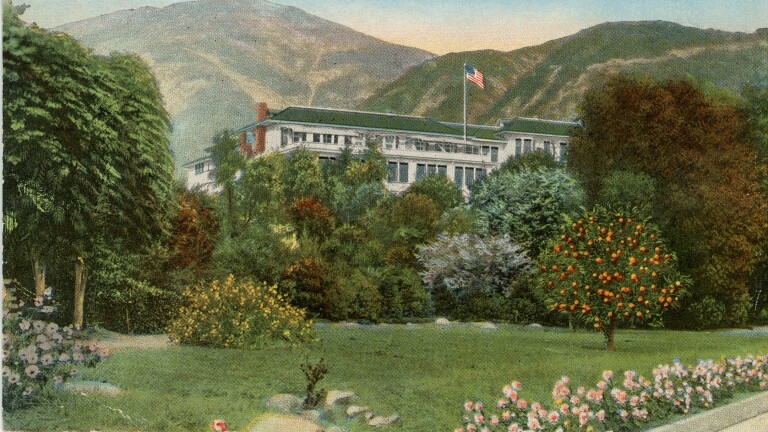Before Downtown L.A.'s High Rises, Bunker Hill Was Simply Home

In the fall of 1964, Gordon Pattison stood in the hallway of the Castle on South Bunker Hill Avenue, the house his family had owned for close to thirty years. The decorative glass in the front door was covered with plywood, the crescent moon-shaped window over the door had disappeared, and a few dusty beads dangled from a formerly ornate glass chandelier above his head. Gordon's grandmother Margaret Henderson Pattison, who in 1937 had initially leased, then bought the house was gone. So too was Ollie Harp, who lived in the front room and managed the property for the family when Margaret passed away.
After years of wrangling, the City of Los Angeles' Community Redevelopment Agency had officially acquired the property. The building's last remaining tenants had been evicted and shortly thereafter, the Castle was surrounded by a chain link fence and abandoned.
The neighborhood of Bunker Hill in downtown Los Angeles has been the subject of countless books, blogs and films. For Pattison and many others, it was home.

Located on a hill overlooking downtown Los Angeles, Bunker Hill was a tight-knit community of individuals who gossiped in parlors and chatted over garden fences. Kids walked together each day to Fremont Avenue Elementary School, played baseball in the streets on Saturday and bought cold Pepsi-Cola for a dime at the deli on Third and Grand Avenue.
The neighborhood had been laid out in the 1860s. However, as the city grew and the original owners moved away, new families occupied the large houses and apartment buildings. The Hendersons came to Bunker Hill from Indiana in the early 1920s. The family initially settled in the Colonial Arms on 312 South Grand Avenue where Margaret's mother worked as the building manager. Margaret joined her family in 1932 with her husband and son. Forced to quit school in the eighth grade to take care of younger brothers and sisters, Margaret had few options back East. In Los Angeles, she got a job at Bullock's Department Store downtown and, like her mother, began managing apartment buildings on Bunker Hill. In a few short years, Margaret was juggling more than 60 units on the hill.
The soundtrack was pigeons cooing, the rustle of palm branches, and the occasional siren from down below.Gordon Pattinson

In 1937, Margaret leased the Castle at 325 South Bunker Hill Avenue. Five years later, she bought the building. Built in the 1880s, the Castle was an elaborate Queen Anne with a tower, multiple gables and a wrap-around porch. It had been converted to a rooming house in 1902 and included fifteen individual units.
Margaret wasn't the only Henderson to purchase property on Bunker Hill. Her brother Willis bought a building at 339 South Bunker Hill Avenue called the Salt Box because of its similarity to an architectural style found in New England. Margaret's brother Lawrence owned the Crestholme Apartments on South Bunker Hill Avenue until the building was razed to make room for an extension of Fourth Street.
Like many migrants, the Henderson's moved to Los Angeles with limited funds but high hopes. On Bunker Hill, they found themselves among fellow transplants from the mid-West and South, as well as folks from farther afield. According to the 1940 federal census, 92% of the family's immediate neighbors were born outside of California. While most were born in the United States, close to 16% had emigrated from elsewhere, including France, Germany, England, Finland, Poland, Turkey and Iceland. In Los Angeles, these individuals took jobs as clerks, tailors and janitors. Several actors and a pastry chef for a downtown restaurant also lived nearby.
When Margaret passed away in 1943, her son inherited the Castle. Gordon remembers weekend trips to the building to help his father with maintenance. Between fixing leaky toilets and changing light bulbs, Gordon sat on the steps of the front porch. At this time, Bunker Hill was a "tranquil oasis above a busy city down below. The streets were not big thoroughfares with heavy automobile traffic. The soundtrack was pigeons cooing, the rustle of palm branches, and the occasional siren from down below."
People talk about the buildings and that kind of thing, but it's the people who experienced them who really matter.Gordon Pattison

Among Gordon's most vivid memories are his frequent trips on the Angels Flight funicular. It "was a terrific thrill ride. Because the cars look like they're going to hit head on. They can't possibly miss. But at the last second, they lurch past one another and miss each other by inches. That pass happened above Clay Street on an elevated track, and if you're going downhill above the cutout for the Third Street tunnel, it looked like you were going to be launched out over the precipice, but you never were. Somehow or another, you survived every single time. And you had all that adventure for a nickel!"
Today, the Victorian mansions of Bunker Hill are often remembered nostalgically, but the community was also a vibrant, walkable neighborhood in the middle of a bustling downtown. It was well connected to public transit and exactly the kind of affordable neighborhood city planners aspire to create now.
In 1964, as a designated Los Angeles Cultural Heritage Monument, the Castle was destined for a new life as a contributor to the Heritage Square Museum. Unfortunately, shortly after its move, the building was destroyed in an arson fire. However, a few things from the old Bunker Hill survive. On the southern slope of the hill at Fourth and Olive Streets, a retaining wall that was part of the 1902 Fremont Hotel still stands. Surprisingly, the half-moon glass above the door of the Castle also recently surfaced. And of course, a family's memories survive. As Gordon notes, "people talk about the buildings and that kind of thing, but it's the people who experienced them who really matter."

Source Notes:
This article is drawn from an interview conducted by Brannon Smithwick of USC's Masters in Heritage Conservation Program with Gordon Pattison on January 29th, 2021 for the Bunker Hill Refrain project.









